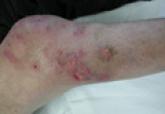Nocardia is relatively easy to grow in culture from cutaneous lesions, but a few idiosyncrasies should be noted. A native to soil and decaying vegetation, N brasiliensis grows easily on common culture mediums in aerobic conditions, but supplementation with 10% CO2 may promote colony growth.6 The colonies themselves will develop a velvety appearance on the agar because of its aerial hyphae. These colonies start very small and may be slow growing; therefore, there is a risk of plate overgrowth by contaminant bacteria.2,6,11 Some laboratories will discard cultures after 3 to 7 days if there is no growth, which adds to the risk of delayed diagnosis. If N brasiliensis is considered in the differential diagnosis, the laboratory should be notified because the cultures may take several weeks to grow colonies large enough for identification.2 Some authors recommend keeping Nocardia cultures for 6 weeks before discarding them as negative.10 More rapid diagnosis may be made by skin biopsy and microscopic evaluation of the lesion.11
There is a tendency for local recurrence of the infection, which requires a longer course of oral antibiotics.1,6 Treatment of chronic lesions may demand up to one year of oral antibiotics. Trimethoprim-sulfamethoxazole has a high therapeutic-to-toxic ratio and synergistically inhibits folate metabolism in Nocardia, effectively killing the organism.1N brasiliensis also has demonstrated adequate sensitivity to minocycline, providing a viable second choice of therapy.6
N brasiliensis is an uncommon infectious agent. When infection does occur, it is often misdiagnosed, which prolongs the treatment course and increases the potential for chronicity. This organism should be considered in penetrating hand injuries contaminated by soil; cutaneous infections that worsen despite surgical debridement and standard antibiotics; recurrent cutaneous infections; and infections in which sporotrichosis is a possible etiology.6 In suspected cases of N brasiliensis infection, clinicians should notify the laboratory to prolong the duration of incubation. When the diagnosis of N brasiliensis infection is made, a prolonged course of oral antibiotics is recommended.


